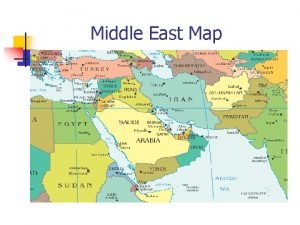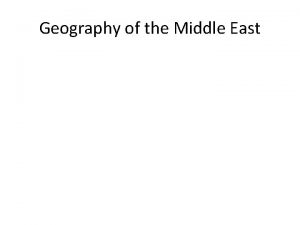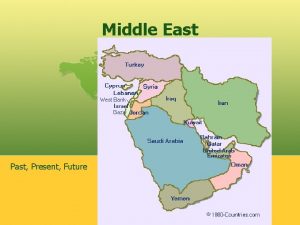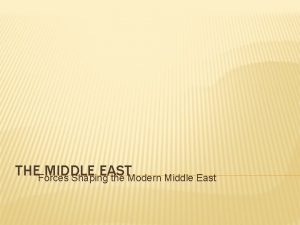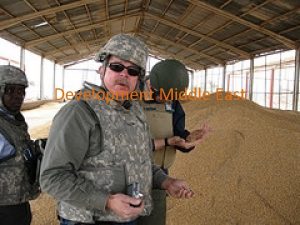Sixth Annual Middle East Vis PreMoot Training Preparing

















- Slides: 17

Sixth Annual Middle East Vis Pre-Moot Training Preparing for Oral Argument, Part I Creating an Outline and Using a Binder 1

What is an Argument Outline? • The Outline is the basic structure of your argument, in written format, from start to finish. • The Outline is NOT the argument written word-for-word. 2

The Outline: • Offers you a way to plan your argument, so that each thought flows logically into the next (just as in your memo); • Provides a visual reference for you in case you become sidetracked by questioning and need to quickly return to where you left off. • Helps you prepare for oral argument. 3

Creating the Outline What goes into it? • • Argument Introduction and Roadmap; Key points of your argument; Important transitions; Citations to the Record and other sources; Back-up arguments; Visual cues, if you need them; Argument Conclusion. We’ll discuss the Introduction and Roadmap in more detail later on! 4

Creating the Outline How to get started: • Start with the argument headings from the written memoranda. • Create a document using these headings to guide your oral presentation from start to finish. • PRACTICE. • Change the format, structure, or design of your outline as often as you need to in order to adapt and improve your argument. • The more you practice, the more your confidence will improve, and the less you will depend on your outline to guide your argument. 5

Creating the Outline 1) The Outline should not be distracting to the arbitrators. • Multiple pages are confusing and can easily get out of order, taking your attention away from the argument and visually distracting the arbitrators. • Small notes or loose notebook paper can become scattered, and appear untidy. BEST PRACTICE: Keep your outline neat and orderly, and to a minimum number of pages (1 -3 is ideal). 6

Creating the Outline 2) It should be easy for you to use. • Very small print, or a handwritten outline, may be difficult to reference quickly. • Complicated outlines, with crowded lines or long blocks of text, will likely overwhelm you during oral argument. BEST PRACTICE: Type your outline in 12 -size font or larger, and leave space between lines so you can glance down and reference arguments quickly and easily. 7

Creating the Outline 3) It should never be something you read to the arbitrators. • This is the most difficult part, and it will take a lot of time and many, many practices and rehearsals to master. • The outline is for your reference, but it must not be a crutch. • Reading your argument or your outline word-for-word is an unacceptable practice in oral argument, and you will lose points for doing so. BEST PRACTICE: Create an outline, and practice with it as often as you can, perhaps multiple times a day. Learn it backwards and forwards. Then, force yourself to do your whole argument entirely without it. 8

Using the Outline • Keep your outline placed in front of you on the table. • Glance down as you need to in order to reference a fact, a record page number, or to remind yourself of where you left off should you become sidetracked. • Do not read your outline to the arbitrators. • Do not shuffle pages, which is loud and distracting. 9

Best Practices • Stay Flexible. • Change your outline often. What you write during this training should not be the outline you ultimately use in Vienna. • Be Prepared to go “Off-Road. ” • Arbitrators will ask you questions that require you to jump around in your argument, and you must answer the arbitrator’s questions. Be prepared to deviate from the order of arguments you have prepared, and use your outline to help you find your thread after you’ve answered the question. 1 0

Final Things to Note • More and more often, i. Pads are used during the competition to keep the outline, and arbitrators seem quite open to this practice. You can do whatever you are most comfortable with. • The best advocates are able to deliver their argument without relying on their outline at all. Nonetheless, having one in front of you in case of emergencies is always a good idea. 1 1

Any questions about the Outline?

The Binder What is the purpose of a Binder? • Organizes resources; • Quick and easy access to briefs and the problem; • Puts critical information at your fingertips in order to answer questions from the Arbitrators that you may not know immediately, or verify your arguments; • Promotes teamwork. 1 3

The Binder What should be included? Vis Problem Argument Outlines The CAM-CCBC Rules The UNCITRAL Model Law NY Convention Any other necessary, frequently cited sources (such as case briefs, important commentaries, etc. ) • Claimant and Respondent Memos • Vis Rules • • • 1 4

The Binder can hold other important items as well: • Time cards, if you are using them; • Highlighters and pens/pencils; • Scratch paper or pads of paper for note-taking. *Always remember: the Binder should never be a distraction to the arbitrators. 1 5

The Binder Why is it important? • Tidiness: teams with messy, disorganized tables sacrifice points. • Teamwork: teams that use the binder well score teamwork points (remember: “do your homework”!) • Verification: Arbitrators want to know you have proof to back up your arguments. Having a piece of paper to hand them, if asked for it, demonstrates preparedness and scores more points. 1 6

Any final questions?
 Peter piper picked
Peter piper picked Rubber baby buggy bumpers tongue twister lyrics
Rubber baby buggy bumpers tongue twister lyrics Kalahari desert on africa map
Kalahari desert on africa map Declinazione vis
Declinazione vis Liryka
Liryka Elements of poem
Elements of poem Vis a vis
Vis a vis Vis a vis unai
Vis a vis unai East south east wind direction
East south east wind direction East is east and west is west
East is east and west is west Annual security refresher training
Annual security refresher training Middle east latitude
Middle east latitude Ethnic groups in the middle east
Ethnic groups in the middle east Why is it called the middle east
Why is it called the middle east Inlet of indian ocean between africa and asia
Inlet of indian ocean between africa and asia Jordan river on map
Jordan river on map Physical features of the middle east map
Physical features of the middle east map Middle east countries and water
Middle east countries and water


























